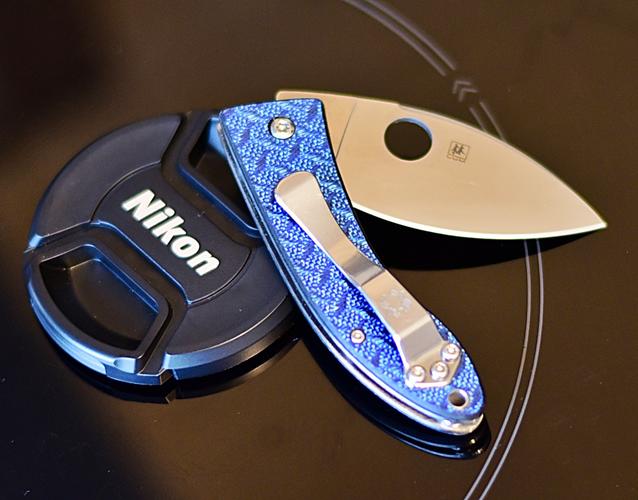Results 1 to 10 of 3708
Thread: Hone of the Day
Hybrid View
-
09-30-2019, 11:19 AM #1Senior Member

- Join Date
- Sep 2014
- Location
- Boise Idaho
- Posts
- 199
Thanked: 12
I get where you are coming from but... It was actually the Ura that was wonky. I had expected the opposite. The Omote side (soft iron) came in quite easily without having to remove much steel. The Ura (front side with kanji) had uneven voids in the steel at the spine causing a teetering effect until it was flattened out a bit. This was a virgin kamisori with zero hone wear prior to this honing session.
-
10-01-2019, 12:06 AM #2

OK, let me pull you up there again
 Ura means back in Japanese not front but I get the issues you're describing. Sounds like the steel went for a bit of a walk in the quench.
Ura means back in Japanese not front but I get the issues you're describing. Sounds like the steel went for a bit of a walk in the quench.
With larger kataba (single bevel) tools such as knives it is possible to straighten any warps prior to honing. Flattening the back (ura) on chisels is also done & is called ura-oshi. The back of the chisel is not completely flattened, the hollow is retained but a bevel & the sides are all trued. Might be tricky on something as short as a razor.“The white gleam of swords, not the black ink of books, clears doubts and uncertainties and bleak outlooks.”
-
10-02-2019, 12:41 AM #3

I honed up a Sheffield blade on Saturday that really seemed to be sharp. It was cutting through arm hairs with ease, and in my case that usually means it will be a good shaver.
It did technically shave, but it certainly wasn't a good shave.
I decided to try looking at the edge through a loupe. I couldn't see anything out of the ordinary. I compared it to one of my best shaving razors (again under a loupe) and I couldn't tell much difference between the two. It was only when I looked at an unhoned razor under the loupe that I could see the light reflections that I've been told to look for when the bevel is not set.
In regard to this, are you folks who use a loupe able to detect the difference between a blade that is almost there vs one that is going to be a great shaver? Or is this something that only a shave test will reveal? I did look at the scratch patterns on the bevel and those didn't appear significantly different.
Also, if your shave test wasn't quite there, how far back in your progression would you go- all the way to the bevel setter, maybe somewhere in between?Last edited by sonnythehooligan; 10-02-2019 at 01:06 AM.
-
10-02-2019, 02:00 AM #4Senior Member




- Join Date
- Feb 2013
- Location
- Haida Gwaii, British Columbia, Canada
- Posts
- 14,401
Thanked: 4822
Yes,I can see when it is almost a set bevel and when it is a completely finished apex.
While looking almost straight on the point of the apex and using a decent loupe and a good light source, the missing part of the apex shows white of a bright reflection. A truly finished apex is very difficult to identify because it is much more narrow and does not reflect light back but you can roll it and see one bevel and across to the other. It’s hard to describe. It would be easier if we were honing together.It's not what you know, it's who you take fishing!
-
The Following 3 Users Say Thank You to RezDog For This Useful Post:
evnpar (10-02-2019), sonnythehooligan (10-02-2019), Steel (10-03-2019)
-
10-02-2019, 02:19 AM #5

Yeah, one of these days I need to head to one of those meet ups.
-
10-02-2019, 02:26 AM #6Senior Member




- Join Date
- Feb 2013
- Location
- Haida Gwaii, British Columbia, Canada
- Posts
- 14,401
Thanked: 4822
I first learned my basics from Glens videos, then from a great guy in Edmonton, then from Glen, then from new and older members at meets. It is pretty amazing how you can pick stuff up in a flash in person. Two people with a common interest is a meet!
It's not what you know, it's who you take fishing!
-
10-03-2019, 09:29 AM #7

Decided to have a little fun with my own little pocket knife, a Spyderco Bob Lum made in Japan made from VG10, thought I would try and put this little knife in the same sharpness levels of razor territory, I have in my knife sharpening kit stones going from 400 right through to a Naniwa 12K, well all I will say the knife was finished on the Naniwa 12K stropped on leather and yes indeed it did pass the HHT and I now have a shave ready pocket knife .

 “Wherever you’re going never take an idiot with you, you can always find one when you get there.”
“Wherever you’re going never take an idiot with you, you can always find one when you get there.”


 23368Likes
23368Likes LinkBack URL
LinkBack URL About LinkBacks
About LinkBacks







 Reply With Quote
Reply With Quote
